
Thunderbolt is Intel's brainchild and to be honest, is an odd inclusion on what is essentially a budget, low power board that is likely to find itself wanting to hook up to TVs or monitors and a router, be it over WiFi or Ethernet. Thunderbolt devices are also pretty expensive and thin on the ground compared to USB 3 too, and the lack of both USB 3 and an Ethernet Port on the D33217CK are odd omissions indeed.
The BLKD33217GKE at least comes with an Ethernet Port, but USB 3 would have been the icing on the cake as far as we're concerned. There are two laptop-size SODIMM slots, able to take a maximum of 16GB of RAM, three USB 2 ports, with a further two via a single on-board header, and of course the Thunderbolt port located on the outside of the PCB, along with the 12V DC power connector.
For storage, there are no SATA ports - instead a full-length mini PCI-E port allows the use of mSATA SSD's. Thankfully, these aren't much more expensive than their 2.5in counterparts, although it does mean that any extra storage that's connected physically, you'll need to use an external USB 2-connected hard disk. Another option would be to use an mSATA/mini PCI-E to SATA adaptor, which would allow you to use an existing SSD, although we're not sure if there's enough power on tap for a 3.5in hard disk.
There's also a half-length mini PCI-E port located beneath the top one, although its size is likely going to limit it to WiFi module use only. Apart from the need for an external power adaptor, the rest of the PCB is pretty familiar. There are the usual headers for reset and power buttons, mounting holes and even an on-board power button located on the underside.
This is also where the embedded CPU lives along with its dinky cooler. The cooling setup is not dissimilar to laptops and even graphics cards, with a tiny fan drawing air in and blowing it out the side. It's assisted in the war against the very modest heat the CPU generates by a large heatsink, which straddles both the CPU and the smaller QS77 chipset to the side.
The BIOS was surprisingly spiritely and responsive, and even allowed for a modicum of memory overclocking, with plenty of options to tweak various settings. Speedstep can be turned off, or you can apply a more aggressive energy-saving profile, while cooling is also catered for fairly extensively with the ability to fine-tune the fan speed based on temperature.
We used 4GB of 1,600MHz Corsair RAM (2 x 2GB sticks) with the NUC D33217CK, along with a 120GB Intel 525 Series mini PCI-E SSD and ATHEROS AR5B95 Wifi module for testing. Head over the page to see the results.
Click to enlarge
The BLKD33217GKE at least comes with an Ethernet Port, but USB 3 would have been the icing on the cake as far as we're concerned. There are two laptop-size SODIMM slots, able to take a maximum of 16GB of RAM, three USB 2 ports, with a further two via a single on-board header, and of course the Thunderbolt port located on the outside of the PCB, along with the 12V DC power connector.
For storage, there are no SATA ports - instead a full-length mini PCI-E port allows the use of mSATA SSD's. Thankfully, these aren't much more expensive than their 2.5in counterparts, although it does mean that any extra storage that's connected physically, you'll need to use an external USB 2-connected hard disk. Another option would be to use an mSATA/mini PCI-E to SATA adaptor, which would allow you to use an existing SSD, although we're not sure if there's enough power on tap for a 3.5in hard disk.
Click to enlarge
There's also a half-length mini PCI-E port located beneath the top one, although its size is likely going to limit it to WiFi module use only. Apart from the need for an external power adaptor, the rest of the PCB is pretty familiar. There are the usual headers for reset and power buttons, mounting holes and even an on-board power button located on the underside.
Click to enlarge
This is also where the embedded CPU lives along with its dinky cooler. The cooling setup is not dissimilar to laptops and even graphics cards, with a tiny fan drawing air in and blowing it out the side. It's assisted in the war against the very modest heat the CPU generates by a large heatsink, which straddles both the CPU and the smaller QS77 chipset to the side.
Click to enlarge
The BIOS was surprisingly spiritely and responsive, and even allowed for a modicum of memory overclocking, with plenty of options to tweak various settings. Speedstep can be turned off, or you can apply a more aggressive energy-saving profile, while cooling is also catered for fairly extensively with the ability to fine-tune the fan speed based on temperature.
We used 4GB of 1,600MHz Corsair RAM (2 x 2GB sticks) with the NUC D33217CK, along with a 120GB Intel 525 Series mini PCI-E SSD and ATHEROS AR5B95 Wifi module for testing. Head over the page to see the results.

MSI MPG Velox 100R Chassis Review
October 14 2021 | 15:04

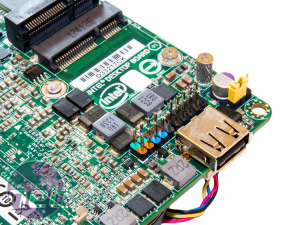
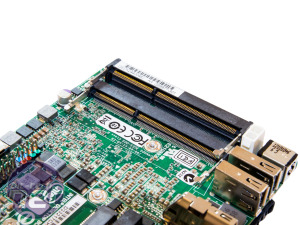
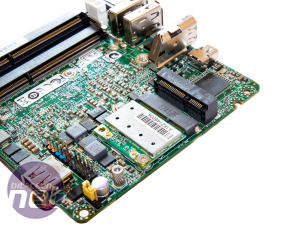

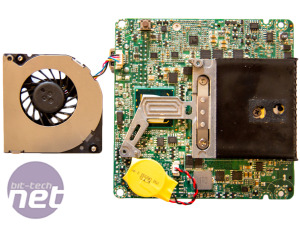
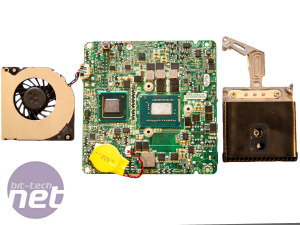
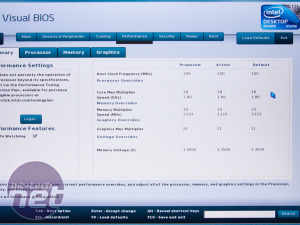
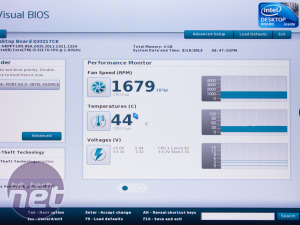







Want to comment? Please log in.